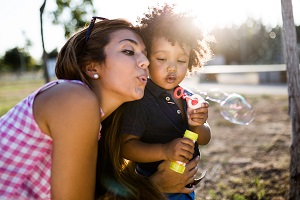10 Bubble Play Ideas for Busy Youngsters
Playing with bubbles seems like simple child’s play. But, it’s simple activities that are most effective at building overall brain and body development in children. Face it, bubbles are magical. I call them “magic in a bottle.”
Any pediatric therapist will tell you they always have bubbles nearby. While the ways to use bubbles with children are limitless, here are ten ways to use bubbles to promote development in your child—busy or not.
- Quiet watching – Busy babies and young children often need to develop the ability to sit or stand without moving or fidgeting. One way to help your child quiet down is for you to blow bubbles and instruct them to “watch the bubbles.” While it’s fun to get a battery-powered bubble machine, these produce too many bubbles and cause some children to get excited and more active. Slowing down and watching one bubble at a time is calming. This activity also develops better visual tracking, focus, and concentration.
- Touching bubble juice – Tolerating touching different textures, slimy or coarse, is a skill your child needs. Different sensory experiences expand your child’s world and enrich their vocabulary if you use descriptive words as they touch things. For example, your baby will learn what slimy means when she touches slimy bubble juice. She now has a tactile memory to pair with the word slimy. That helps her remember what the word means.
- Calming – Learning to self-calm is an essential developmental skill needed by most busy youngsters who often get too tired and can’t relax. Maybe your baby needs something other than watching the tablet or TV to calm their body. We all know screen time is not healthy. Try using bubbles as a tool to help your child sit still and calm down. It only takes a few minutes, usually. If your baby can blow his own bubbles, it’s even better.
- Blowing bubbles –Babies begin blowing spit bubbles by two months of age and can blow a bubble through a bubble wand by two years old. Let them try even if they can’t. But don’t let them swallow the bubble liquid. The practice of puckering and blowing will strengthen the mouth muscles that are necessary for speech production. There is research that shows toddlers who blow bubbles talk earlier. Again, what seems like silly child’s play contributes to better brain and language development.
- Popping with a hand – Have your baby reach to touch the bubble and swat at it to pop it. This activity improves eye-hand coordination and visual tracking skills. When it pops, say, in an exaggerated fashion, “Pop!” Hearing “pop” over and over teaches your baby the word “pop.”
- Popping by clapping hands – Babies begin clapping hands around nine months. Clapping hands looks like a simple thing. Yet, it requires intricate and complex interactions between both sides of your baby’s brain. When your child can clap hands together, this indicates advancement in brain development. To visually track a bubble floating in the air and pop it between the hands requires much concentration and patience. These are all necessary skills for successful pre-school performance. Say “pop” each time, as discussed above in #5.
- Popping with the pointer finger – Babies learn to point with the index finger between twelve and eighteen months. Pointing is an important communication skill, so improving pointing helps your baby show you what he wants. Popping the bubble with the pointer finger improves finger dexterity and coordination in addition to visual tracking and eye-hand coordination. Again, encourage your baby to say “pop” by saying “pop” each time the bubble pops. See #5 above and remember to exaggerate the word to increase your child’s fun and engagement.
- Popping by stomping or jumping – Many busy youngsters are on the move all the time, or so it seems. They climb on the furniture, run around the house, slam into the sofa, or wrestle the dog. Get out some of that energy by encouraging your child to stomp the bubble or jump on it. These activities promote improved balance, eye-foot coordination, strength, and power. Again, say “pop” each time they pop the bubble. Work those legs along with gaining words for a win-win play activity.
- Easing transitions –Transitioning your child from an activity she loves to one she isn’t eager to do, like running an errand, is not a play activity; however, using play is a proven method to help your child enjoy the transition. For example, transition your baby to the car for an errand by blowing bubbles as you walk. Have her pop them as you slowly take your baby to the car. Or, blow a few bubbles to ease ending bath time and getting pajamas on. Fun transitions always work better than difficult ones.
- Stopping meltdowns– Some children are easy-going, and others are not. These differences are a reflection of your child’s personality and temperament. If your child is mad and falling out on the floor, get out the bubbles! If your little man is hitting or screaming at you because he doesn’t want to put the blocks up, get out the bubbles! Use what the child development professionals use—a timely distraction. Telling them to stop fussing rarely works but distracting them does work.
While easing transitions, stopping meltdowns, or helping your child sit quietly may not seem like play to you, using these play activities with bubbles helps your child learn to control their body (sit or stand still), manage intense emotions (emotional development), and improve visual tracking, eye-hand, and eye-foot coordination. PLUS these activities will assist you, mom, in managing a typical day with a busy child. Sounds like a win-win to me.
To keep up with the latest tips and ask questions, join the Grow with Ginny Instagram community or listen to The New Mom Podcast.
FREE Milestone Chart (Birth to Age 5)
(Photo: Adobe Stock)

